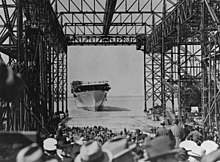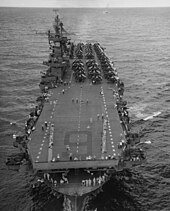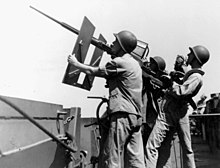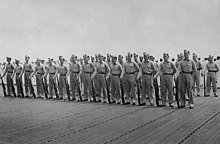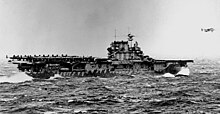Yorktown class (1936)
| Yorktown- class | |
|---|---|
 USS Yorktown (CV-5) in May 1937 |
|
| Overview | |
| Type | Aircraft carrier |
| units | 3 built, all out of service |
| Namesake | Yorktown , Virginia |
| period of service |
1937-1947 |
| Technical specifications | |
| displacement |
19,800 tn.l. |
| length |
246.9 m |
| width |
33.2 m |
| Draft |
8.5 m |
| crew |
2919 men |
| drive |
9 boilers, 4 turbines, 4 screws, 120,000 hp |
| speed |
33 knots |
| Range |
11,200 nm at 15 kn |
The Yorktown- class was a class of aircraft carriers in the United States Navy . The three carriers of the class, which entered service between 1937 and 1941 , together with the two aircraft carriers of the Lexington- class , formed the backbone of the American carrier fleet at the beginning of World War II . Only the USS Enterprise saw the end of the war, but was decommissioned in 1947 and scrapped 13 years later. The other two ships were sunk in 1942, the Yorktown in the Battle of Midway and the Hornet in the Battle of the Santa Cruz Islands .
history
Development and construction
After the construction of the Lexington and Saratoga and the approval of the rangers in the early 1930s, the US Navy faced a decision on how to proceed with the remaining 52,000 ts that were still available to the Navy for the construction of aircraft carriers under the Washington Fleet Agreement would.
One proposal provided for the construction of four more carriers with a displacement of 14,500 ts as with the Ranger , which would have made it possible to accommodate the largest possible number of aircraft on board the carrier fleet. Another suggestion was the construction of two large girders, each with a displacement of 27,000 tons, which would have offered maximum protection. Ultimately, the decision was made to build two medium-sized aircraft carriers, each with a displacement of just over 20,000 tons, as well as a third, small aircraft carrier that exhausted the tonnage limitation of the fleet contract.
The approval of the first two ships of the class took place on June 16, 1933 by President Franklin D. Roosevelt under the National Industrial Recovery Act , which was part of the New Deal policy . The smaller aircraft carrier, the USS Wasp , was approved a year later. The Yorktown was laid on May 21, 1934 at Newport News Shipbuilding , her commissioning took place on September 30, 1937. The sister ship Enterprise followed on May 12, 1938. After the expiry of the treaty provisions of the Washington Naval Agreement in 1938, the naval command decided that To strengthen the aircraft carrier fleet by building another full-fledged fleet carrier. Since no resources were available at the time to work out a new design, the Hornet in the older design of the Yorktown class was launched with almost all restrictions due to the long-obsolete fleet contract in December 1940 and entered service on October 20, 1941 posed.
Use and whereabouts

The three Yorktown-class carriers were assigned to the US Pacific Fleet after their commissioning and deployed from ports on the west coast. Until the Japanese attack on Pearl Harbor , the porters mostly took part in naval maneuvers; after the outbreak of war, the Yorktown , the Enterprise and the Hornet, together with the Lexington and the Saratoga, formed the backbone of the US Navy in the Pacific War . The B-25 bombers took off from the Hornet for the Doolittle Raid on Tokyo, while the Enterprise gave the Hornet cover during the operation. The Yorktown took part in the Battle of the Coral Sea and was badly damaged by bombs. The damage was repaired in record time in the dock in Pearl Harbor, so that she could take part in the Battle of Midway . The Yorktown sank on June 7, 1942 after the battle after several Japanese torpedo hits. Her sister ship Hornet also sank on October 27 after several Japanese torpedo hits in the battle of the Santa Cruz Islands . After the loss of the two carriers, the Enterprise was at times the only operational aircraft carrier of the US Navy in the Pacific. The vulnerability to torpedoes, which had led to the loss of the two sister ships, was reduced during extensive renovations in 1943, and the anti-aircraft armament was increased due to the increased threat from Japanese aircraft. The Enterprise , which took part in almost all battles of the Pacific War, was the most highly decorated ship in the Navy at the end of the war. She was decommissioned on February 17, 1947. Attempts to keep the Enterprise as a museum ship failed for financial reasons, so that it was finally scrapped between September 1958 and March 1960.
units
| Identification number | Surname | In service | Off-duty | Whereabouts / fate |
|---|---|---|---|---|
| CV-5 | USS Yorktown | September 30, 1937 | June 7, 1942 | sunk |
| CV-6 | USS Enterprise | May 12, 1938 | February 17, 1947 | Wrecked in 1960 |
| CV-8 | USS Hornet | October 20, 1941 | October 27, 1942 | sunk |
technology
Hull and armor
The Yorktown-class carriers had an overall length of 246.9 meters, the length in the construction waterline was 234.9 meters. The width of the construction waterline was 25.3 meters, the maximum width of the first two ships was originally 33.2 meters. The Hornet was 34.8 meters wide, during its career the Enterprise was widened to this measure. The draft was between 6.6 and 8.8 meters, depending on the load. The construction displacement was around 19,800 standard tonnes, the operational displacement was between 25,000 and almost 30,000 standard tonnes.
The armor of the porters had been massively increased compared to the ranger , it was a maximum of 102 mm at the waterline level. The armor of the main bulkheads and the command tower was also 102 mm, the hangar deck was reinforced with 76 mm of armored steel. To protect against torpedo attacks, the hulls were provided with a double ship bottom, the side wall was protected by a system of three partially liquid-filled tanks, which were supposed to absorb the pressure wave and the splinters of a torpedo explosion. At the Enterprise, this system was reinforced again in July 1943.
Flight deck and hangar
The flight deck of a Yorktown-class carrier was 16.8 meters above the waterline and was 238 meters long and 24.4 meters wide. As with the Ranger before, the flight deck and hangar were not part of the ship's integral structure, but were attached to the armored hangar deck. The open construction of the hangar, which extended over the middle two thirds of the ship's length, made it possible, thanks to the good ventilation, to warm up the aircraft engines below deck. The hangar openings could be closed with steel roller doors against weather influences or tactical necessities. Three elevators connected the hangar deck with the flight deck above.
The first two ships of the class only had two hydraulic catapults when they were put into service , which were installed on the hangar deck across the direction of travel and were intended to enable reconnaissance aircraft to be launched. It was not until 1941 that they were retrofitted with two catapults on the flight deck; the Hornet received these directly during construction. The porters had two safety rope systems for landing the aircraft on board , one at the stern with nine ropes and one at the bow with four ropes. This enabled ships to land planes over the bow if the aft deck was damaged, a practice that was almost never used. Machines parked on the front deck were protected from landing aircraft by "crash barriers".
island
In the Yorktown class, the bridge superstructures and the chimney were combined into an island for the first time , which was the only superstructure on the upper deck. It carried the navigation bridge, flight and deck control, fire control and radar systems as well as parts of the anti-aircraft armament. The navigating bridge was 26.2 meters above the waterline and just under ten meters above the flight deck, and the top of the mast was 43.6 meters above the waterline.
drive
The four Parsons - geared turbines received their steam at 27.5 bar pressure of nine boilers from Babcock & Wilcox . The total power of the propulsion system was 120,000 shaft horsepower , the maximum speed of the carriers was 33 knots . The fuel supply of almost 7400 tons of bunker oil, twice as much as its predecessor, enabled a maximum range of 11,200 nautical miles at 15 knots.
Compared to the Ranger, this meant a doubling of the propulsion power, the speed of the Yorktown class was four knots higher.
Armament
The original anti-aircraft armament consisted of eight 5-inch guns, 38 caliber length , arranged in pairs below the flight deck edge , in open mountings. The shells of the guns, their muzzle velocity was 762 meters per second, reached a peak altitude of 11,887 meters and were either delayed (mechanical time fuse, time fuse ) and radar-controlled from 1944 (variable time fuse, proximity fuses ) are ignited. The cadence of the guns was between 15 and 22 rounds per minute, this value was strongly dependent on the speed of the operating team. The guns could also have been used against land and sea targets.
As a light anti-aircraft gun , four 1.1-inch quad guns were housed on the island, two each in front of and two aft of the superstructure. The guns had a rate of between 100 and 150 rounds per minute, and the top of the shells was around 5700 meters. These guns were supplemented by up to 24 water-cooled 12.7 mm machine guns .
From June 1942, the anti-aircraft armament was supplemented by 20-mm Oerlikon automatic cannons , Hornet and Yorktown received 24 guns each, Enterprise was equipped with 32 automatic cannons. In August 1942 the number was increased to 32 guns on the Hornet and 38 on the Enterprise . In addition, it was planned to replace the older 1.1-inch guns with 40-mm Bofors guns , but this was only carried out on the Enterprise from November 1942, since the other two ships were lost beforehand. It received four quadruple guns, as well as a further eight 20 mm cannons. In July 1943, two more 40 mm quadruple guns, eight 40 mm twin guns and two more 20 mm guns came on board. The Enterprise received a final armament reinforcement from May 1945, with a total of 54 40-mm guns (eleven quadruple mounts and five twin mounts) and 16 20-mm automatic cannons, it now had enough firepower.
electronics
When commissioned, the Yorktown- class carriers were equipped with the first radar system developed by the US Navy for use on ships. The CXAM radar could locate ships at a distance of up to 16 nautical miles, and aircraft, depending on their size and altitude, up to 70 nautical miles. The Hornet received the radar system recovered from the sunken battleship USS California .
The Enterprise received the end of 1942, an SC-2 radar, could locate the measured with its 4.6 times 1.4 meters antenna aircraft in altitude of 3,000 meters to 80 nautical miles and large vessels to about 40 nautical miles. Later came the SK long-range radar with the characteristic square shape (5.2 × 5.2 m) and the exposed wires of the antenna, which was also known as "bedspring". The radar system was able to locate an approaching bomber at an altitude of 3,000 meters over 100 nautical miles.
For the fire control of the anti-aircraft guns , the carriers were equipped with two Mark 33 systems on the island. The systems, which worked by means of optical and radar detection, were able to track targets horizontally at speeds of up to 320 knots. On the Enterprise , the systems were replaced in July 1943 by the more modern Mark 37 systems, which had a tracking speed of 400 knots horizontally and 250 knots vertically.
Air group
The carriers offered space for up to 90 aircraft, 84 fighter planes and six reconnaissance planes were planned. For reasons of space, however, only a maximum of 80 aircraft were used on board. The Carrier Air Wing consisted mostly of around 20 to 30 fighters, on board the Enterprise during the sea and air battle in the Gulf of Leyte at times 40 fighters, 30 to 35 dive bombers and 20 torpedo bombers. For the carrier aircraft, more than 670,000 liters of aviation fuel and 433 tons of ammunition were carried on board.
Before World War II, Grumman F3F fighters, Curtiss SBC dive bombers, Douglas TBD torpedo bombers, and Grumman J2F reconnaissance planes were used on board the ships. From 1940 the biplane fighter aircraft were replaced by Grumman F4F , from 1941 the Douglas SBD was introduced on board. On the Enterprise from 1943 the Vought F4U was used together with the Grumman F6F as a fighter aircraft, and the Grumman TBF was used as a torpedo bomber . In 1944 the Douglas SBD was partially replaced by the Curtiss SB2C .
crew
In peacetime, the crew of the porters consisted of 86 officers and 1,280 men and non-commissioned officers. In addition, there were another 141 officers and 710 crews of the Carrier Air Wing, making the maximum manning 2217 men. During wartime, the manning increased to 2,919, especially due to the reinforcement of the anti-aircraft armament and the stationing of a detachment of the US Marines on board.
camouflage
By the start of the war, all three ships were painted in scheme 1 , a single-color painting of all vertical surfaces in light gray. After the start of the war, the Yorktown and the Hornet were painted in scheme 12 , which was modified in the case of the Hornet in such a way that the dividing line between Sea Blue and Ocean Gray was pronounced undulating. The Enterprise wore from the end of 1941 to July 1944 and from May 1945 to the decommissioning of Scheme 21 , a complete paint scheme in Navy Blue. Between July 1944 and May 1945 it was painted in camouflage scheme 33 , a mixture of Haze Gray (hazy gray), Pale Gray (pale gray) and Ocean Gray (ocean gray) in pattern 4AB, which consisted of large areas. This "disruptive" or "dazzle camouflage" pattern was intended to mislead observers about the size, speed and direction of travel of the ship.
Additional information
literature
- Mark Stille: US Navy Aircraft Carriers 1922-45. Prewar classes (= New Vanguard 114). Osprey Publishing, Oxford 2007, ISBN 978-1-84176-890-8 .
- Stefan Terzibaschitsch : aircraft carrier of the US Navy. 3rd, expanded edition, special edition. Bernard & Graefe, Bonn 2001, ISBN 3-7637-6200-0 .
- Stefan Terzibaschitsch: Combat systems of the US Navy. Weapons and electronics on American warships. Koehler Verlagsgesellschaft, Hamburg 2001, ISBN 3-7822-0806-4 .
- Steve Wiper: Yorktown Class Carriers (= Warship Pictorial. No. 9). Classic Warships Publishing, Tucson AZ 2000, ISBN 0-9654829-8-7 .
Web links
- Yorktown class at globalsecurity.org (English)
Footnotes
- ↑ USS Yorktown in the Dictionary of American Naval Fighting Ships , as of November 4, 2007
- ↑ Yorktown class at microworks.net , as of November 4, 2007
- ↑ USS Wasp at navsource.org as of November 4, 2007
- ^ Silence: US Navy Aircraft Carriers 1922-45. Oxford 2007, p. 35.
- ↑ Terzibaschitsch: aircraft carrier of the US Navy. Bonn 2001, p. 342.
- ↑ a b Terzibaschitsch: aircraft carrier of the US Navy. Bonn 2001, p. 52.
- ↑ a b Silence: US Navy Aircraft Carriers 1922-45. Oxford 2007, 34
- ↑ Terzibaschitsch: aircraft carrier of the US Navy. Bonn 2001, p. 335.
- ↑ navweaps.com, 5 "/ 38 (12.7 cm) Mark 12 , as of November 4, 2007
- ↑ navweaps.com, 1.1 "/ 75 (28 mm) Mark 1 and Mark 2 , as of November 4, 2007
- ^ Silence: US Navy Aircraft Carriers 1922-45. Oxford 2007, 36
- ↑ Terzibaschitsch: Combat systems of the US Navy. Hamburg, 2001, p. 90.
- ↑ Terzibaschitsch: Combat systems of the US Navy. Hamburg, 2001, p. 94.
- ↑ Terzibaschitsch: Combat systems of the US Navy. Hamburg, 2001, p. 99.
- ↑ Terzibaschitsch: Combat systems of the US Navy. Hamburg, 2001, p. 149.
- ↑ Terzibaschitsch: Combat systems of the US Navy. Hamburg, 2001, p. 153.
- ↑ cv6.org, Dimensions and Propulsion , as of November 8, 2007
- ^ Wiper: Yorktown Class Carriers. Tucson AZ 2000, p. 36.
